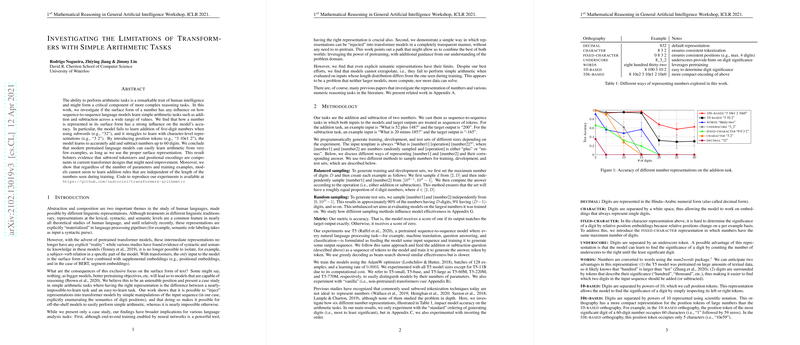Investigating the Limitations of Transformers with Simple Arithmetic Tasks
The paper "Investigating the Limitations of Transformers with Simple Arithmetic Tasks" presents an in-depth examination of sequence-to-sequence LLMs, particularly the T5 model, in performing basic arithmetic tasks. Despite the capabilities of modern LLMs, arithmetic tasks expose notable weaknesses, especially in how numerical representations influence model accuracy.
Key Findings
The experiments detailed in the paper reveal that the surface representation of numbers significantly impacts the model's ability to learn arithmetic operations such as addition and subtraction. Specifically, the paper considers several orthographic representations for numbers, including decimal, character, fixed-character, underscore, words, 10-based, and 10e-based formats. Among these, the 10e-based representation, which involves using scientific notation, enables models to effectively learn arithmetic for numbers up to 60 digits with minimal examples. This performance is attributed to the explicit position tokens, which allow the model to discern digit significance effortlessly.
Contrastingly, other representations such as decimal and character formats lead to poor performance, particularly with larger numbers. The results indicate that decimals are not systematically tokenized into individual digits, complicating the learning process.
Furthermore, the paper underscores the limitations of transformers in extrapolation tasks; that is, their failure to generalize arithmetic operations to numbers longer than those seen during training. A notable observation is that model size influences performance, with larger models like T5-3B demonstrating superior interpolation and extrapolation capabilities compared to smaller models.
Methodological Approach
To comprehensively evaluate the T5 model's arithmetic capabilities, the authors generate datasets with varying number lengths using balanced and random sampling methods. Training involved 100,000 examples, with test accuracies evaluated on both balanced and random distributions. Experimental methodologies included both pretraining and training from scratch to assess how prior training on language tasks influences the ability to learn arithmetic.
Implications and Future Directions
The findings advocate for improvements in subword tokenizers and positional encodings in transformers. While the current pretraining paradigms allow models to interpolate within observed distributions, they fall short in generalizing arithmetic to unencountered scenarios. This limitation raises critical questions about the broader ability of these models to perform more complex reasoning tasks reliant on arithmetic competence.
Potential future research paths include exploring alternative representations and embedding strategies that emphasize the semantics of numerical operations beyond mere surface forms. Additionally, given the paper's insight on the inadequacies of positional encodings, further investigation into innovative positional embedding mechanisms could prove fruitful.
Conclusion
This work contributes to understanding the transformer model's deficiencies in handling numerical tasks, highlighting the crucial role of numerical representation in learning. While transformers are potent tools for various NLP tasks, their inability to fully grasp arithmetic operations without appropriate data representation suggests that further refinement in tokenization and embedding methods is necessary. This research illuminates critical areas for development within model architectures to deepen their reasoning capabilities.
